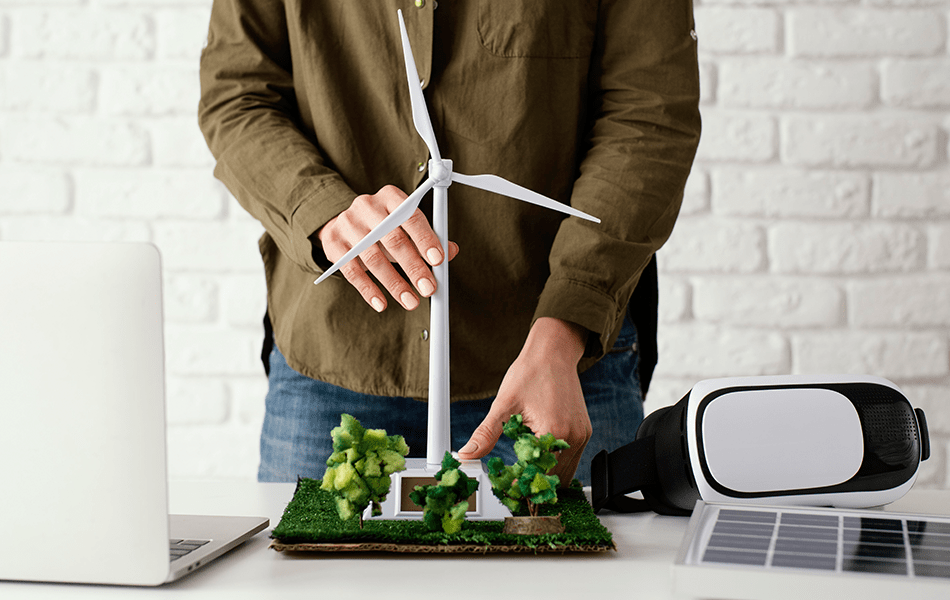In recent years, there has been an increasing worry about the environmental impact of human activities. We are all faced with the enormous problem of reducing our carbon footprints. However, it is one that we must confront if we are to leave a livable planet for future generations. As a result, many people are seeking ways to reduce their carbon footprint and contribute to sustainability. Making little changes and small efforts in our daily lives is one way we can progress toward sustainability. This includes practices such as planting trees, recycling more, driving less, and eating less meat.
Investing in eco-friendly products and sustainable gadgets for our homes is another approach to reducing our ecological footprint. These devices are intended to help minimize energy use and encourage environmentally friendly living. These products can help us save energy, water, and money while also benefiting the environment. Here are seven eco-friendly house gadgets to get you started on the path to sustainability.
What is eco-friendly design?
Green design, often known as eco-friendly design, is a design method that incorporates sustainable concepts into the design process. It focuses on lowering a product’s environmental impact, from material procurement to manufacturing and consumption. Green design for a home entails looking for ways to reduce energy consumption, water waste, and carbon emissions. Eco-friendly design also considers the health and well-being of the people who live in that environment. The goal of green products is to produce sustainable products with a design that makes sense and is both sustainable and efficient, with the least amount of environmental effect feasible, while still delivering comfort and pleasant aesthetics.
How can technology make my home more sustainable?
The solution lies in eco-friendly home appliances. Greenhouse gadgets, or eco-friendly house gadgets, are created with sustainability in mind. Eco-friendly house gadgets, ranging from sensors and smart items to innovative materials and energy sources, can help you conserve energy, preserve natural resources, less plastic waste, decrease water waste, and improve the design of your home. Here are some of the most popular eco-friendly home gadgets on the market:
1. Smart Sensors
Smart sensors are sensors that can gather and interpret data in real-time. They are built to be exceedingly accurate and dependable, making them a necessary component in many current technologies. The capacity of smart sensors to deliver real-time data is one of their most significant advantages. This means they can notice changes in the environment as they occur, allowing them to respond quickly and efficiently.
Smart sensors, for example, can be used to monitor air quality in a building, detect changes in temperature or humidity, and alter ventilation systems as needed. Smart sensors enable you to track and regulate your energy consumption and water waste in real-time. You can optimize your energy usage, reduce your electricity costs, and track your water and electricity usage by using sensors and algorithms.
2. Solar Panels
These gadgets convert sunlight into electricity, giving homes, companies, and communities a clean and renewable source of power. For starters, solar panels are eco-friendly since they emit no greenhouse gases or other hazardous pollutants. As a result, they are an excellent answer for lowering our carbon footprint and mitigating climate change.
By lowering dependency on traditional fossil fuels, solar panels can help consumers save money on their energy costs. They promote energy independence by enabling individuals and communities to own renewable resources to create their own electricity. Solar panels are an excellent way to get solar power to generate energy without relying on the grid. These panels capture the energy from the sun and turn it into usable electricity.
3. Home Automation Systems
Home automation systems have grown in popularity in recent years as technology has evolved and made it easier to remotely control many components of a home. With the touch of a button, homeowners can control everything from lighting and temperature to home security cameras and entertainment. This allows you to save energy by shutting off superfluous lights and adjusting your thermostat to an ideal setting. Convenience is one of the primary advantages of home automation systems. Homeowners can use these systems to program their lights and thermostats, ensuring that their houses are constantly pleasant and well-lit. They can even remotely monitor their homes, employing cameras and sensors to keep a check on things while they’re gone. Energy efficiency is another advantage of home automation systems. Homeowners can save money on their energy bills while lowering their carbon footprint by operating their heating and cooling systems more efficiently.
4. LED Lights
LED bulbs or light-emitting diodes are energy-saving bulbs that are rapidly replacing traditional incandescent and fluorescent bulbs in homes and businesses throughout the world.One of the primary benefits of LED lights is their long life. They can last up to 50,000 hours or more, far outlasting other types and brands of bulbs. Furthermore, they use less energy than traditional bulbs, making them an environmentally friendly option that can help consumers save money on their electricity bills. LED lights are an excellent method to save energy and reduce your power cost. LED lights use up to 90% less energy than traditional lighting systems and last up to 25 times as long as incandescent bulbs.
5. Smart Plugs
Smart plugs are a relatively new development in the world of home automation. They are small devices that plug into any electrical outlet and allow you to control the power supply to any connected device. This means you may use your phone, smartphone, or tablet to turn on or off your lights, TV, or any other item from anywhere in the world.
One of the most significant advantages of smart plugs is their capacity to save energy. You may save money on your electricity bill and assist the environment by shutting off appliances when they are not in use. Smart plug also give an extra degree of security by allowing you to turn on lights remotely while you’re gone. Smart plug allows you to control how your devices are used. You can operate your appliances, lighting, and gadgets remotely from anywhere. You won’t have to worry about forgetting to turn off your devices when you leave the house.
6. Water Filtration Systems
For ages, water filtration devices have been used to purify water for drinking and other purposes. The ancient Greeks filtered water using clay pots, while the Egyptians used sand and gravel. There are numerous water filtration systems available today, ranging from simple carbon filters to complicated reverse osmosis systems.
Using a water filtration system removes pollutants from the water, making it safer and healthier to consume. This is especially crucial in locations where the local water supply has been contaminated by bacteria, harsh chemicals, or other potentially dangerous contaminants. Another advantage of employing a water filtering system is that it can enhance water’s taste and odor.
Many people believe that filtered water tastes better than tap water because chlorine and other contaminants are removed. Water filtration systems eliminate pollutants from your water source while also reducing waste. Filtration systems improve the quality of your water while decreasing your utility expenditures.
7. Smart Home Systems
Smart home technology has transformed how we interact with our houses. These systems make use of technology to automate and regulate different parts of a home, including lighting, heating, security, and entertainment. They add convenience, comfort, and energy efficiency to our homes while also improving safety and security.
The capacity of smart home devices to learn from our behaviors and preferences is one of their primary advantages. They can, for example, regulate the temperature based on our daily activities or switch off lights when we leave a room. This saves electricity while simultaneously lowering our carbon footprint.
Overall, eco-friendly house gadgets are an excellent way to improve the sustainability of your own life and home while lowering your environmental impact. From solar panels light bulbs to smart sensors, these devices can help you save energy and water while also running your home more efficiently.
What are the benefits of using eco-friendly house gadgets?
Using eco-friendly house devices in your home has a number of advantages. Some of the reasons why you should choose eco-friendly housewares include:
- Reduced Energy Usage – Eco-friendly home gadgets might help you use less energy. These devices are intended to use less energy, making them more efficient and cost-effective.
- Reduced Water Usage – Water filtration systems and smart water systems aid in the reduction of water waste by providing real-time data on water consumption. You will be able to better manage your water consumption as a result of this.
- Lowered Utility Bills – Eco-friendly home gadgets help you save energy and water, which can lead to cheaper utility bills.
- Increased Property Value – Installing eco-friendly home appliances can raise the value of your home. Potential buyers may be more willing to acquire a home with eco-friendly features.
- Reduced Environmental Impact – Eco-friendly home appliances help to lessen your environmental impact by utilizing renewable energy sources and lowering energy and water use. This is an excellent approach to contribute to a more sustainable way of life.
It is reasonable to claim that with the correct eco-friendly gadgets and lifestyle modifications, our homes may become more sustainable and efficient. There are numerous other eco-friendly gadgets for home, eco-friendly electronic products, and accessories that you can use to make your home more energy efficient, green, and eco-friendly. The alternatives are unlimited, whether you choose solar panels or LED lighting.
Furthermore, there are numerous other ways to make your home more environmentally friendly. Your home may simply become more energy efficient by properly insulating it, installing energy-saving appliances, and converting to LED lighting. You can also conserve water by taking shorter showers, doing full loads of laundry, and only running the dishwasher when it is full.
Making minor but major improvements and investing in a few eco-friendly gadgets will benefit both the planet and the environment and your budget.
Written by: Sarah Mae Estrella





